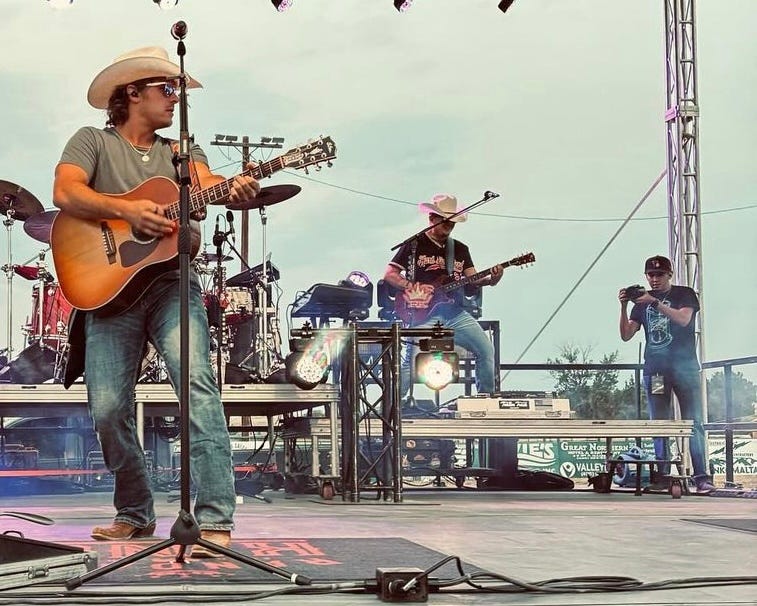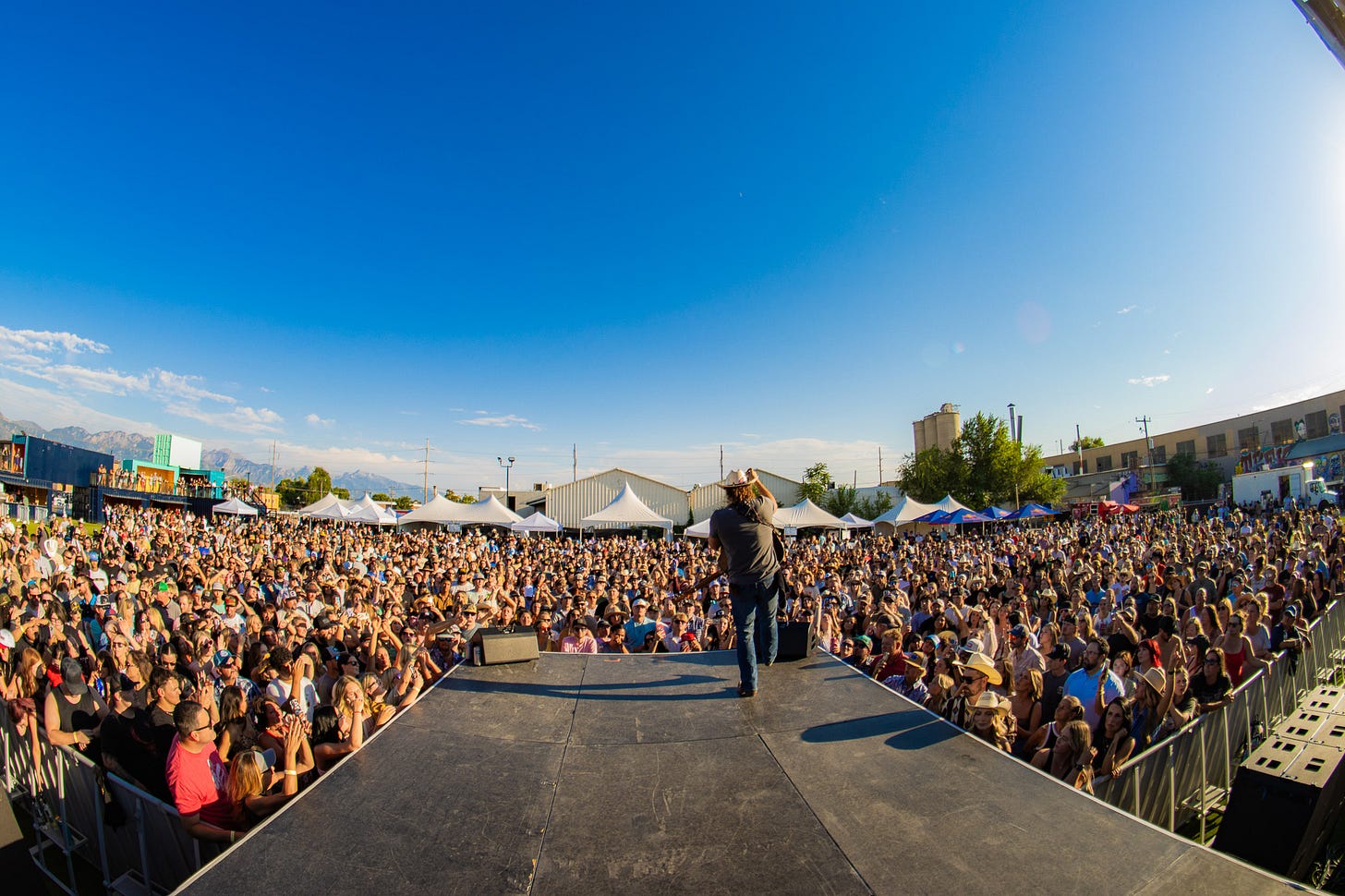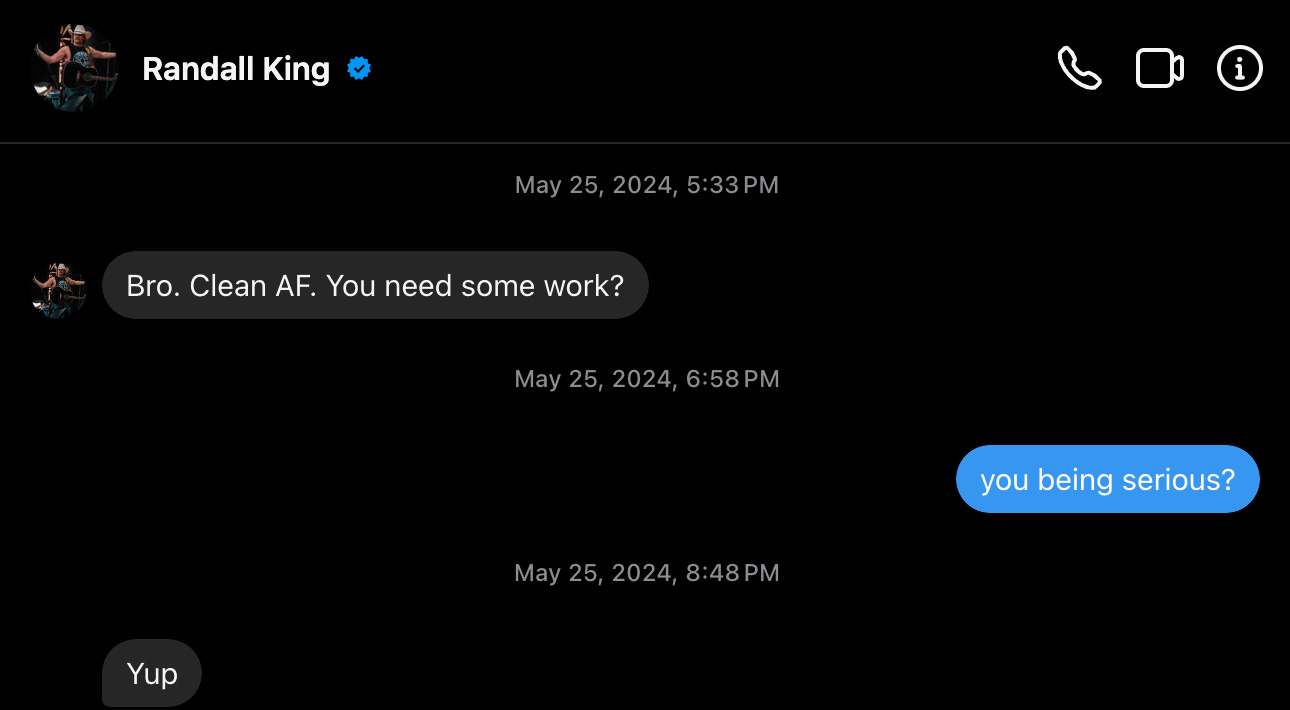Honky Tonkin, Ten Days on the Road, and Questions Left Unanswered
A quick recap of 10 days on the road with Randall King and answering two questions I didn't on Instagram
On May 25th, I was just having another normal evening.
I was at Concrete Street Amphitheater here at home in Corpus Christi, Texas, shooting a Memorial Day weekend festival headlined by Randy Rogers Band and Flatland Cavalry. When I’m shooting a show, I don’t usually pay attention to my phone. However, in between songs while I stood far in the back, I decided to check my phone just to see if I had missed anything and man had I ever.
I opened my phone and was greeted by an Instagram DM from Randall King, one of the leaders of country music’s neo-traditional movement, who had played at sister venue Brewster Street Icehouse the night before. I had posted pictures on Instagram before I left for the Memorial Day show and I guess they were slid across Randall’s desk. His message was simple, “Bro. Clean AF. You need some work?”
I thought it was a joke, imposter syndrome still makes me wonder if I ever actually deserved to get the offer, but here I sit in my bedroom at home on the other end of it. My time with Randall started at a songwriter retreat in Austin and culminated in me going on the road for the first time ever. Six shows across five states I had never been to, headlining shows in Montana and Oregon, and opening slots for Billy Currington to cap it off in Idaho and Utah.
For the longest time, I’ve always brushed off touring. I always told friends and fellow photographers that I never felt cut out for it, that I never felt good enough for it, and just sort of accepted that I would never do it. However, when the offer actually comes your way, it’s tough to deny. In my mind, I would rather try and hate it than reject it and regret doing so. Fortunately for me, I loved it.
There are definitely aspects of touring that aren’t great. Sleeping in a giant vehicle that’s flying down small highways in pockets of the country with no cell service in the wee hours of the morning, not knowing what or when you’re going to be able to eat throughout the day, the “hurry-up and wait” flow of some days, and conversely, the thumb-twiddling and trying to find excitement on off-days. There’s also just the aspect of not being home. Randall and his band were in the final two weekends of four straight weeks touring and the thing that everyone was most excited to do was to get home to their families. However, there are plenty of great things too: getting to know the incredible guys in Randall’s band and crew, waking up in cool cities like Rock Springs, WY, or Boise, ID, or just being able to explore cities like Billings, MT and Bend, OR.
Also, there truly wasn’t a greater night than getting to catch up with Braxton Keith and his entire band and crew in a tiny Montana town. It was truly the most fun I had on any show and you could tell that both bands absolutely loved it too.
Selfish highlights for me include getting to meet Billy Currington, getting to hear one of my favorite songs of the year, One Night Dance, live almost every night, and just being able to brand out and prove to myself that I could do it.
Touring also brought upon a unique set of challenges that I’ll talk about in a second but first, I want to add some context. On my last day of the tour, I for some reason had the idea to do a Q&A on my Instagram and posted one of the question boxes on my story. I answered most of them with stories but there are two that I wanted to single out because I don’t think answering them in a quick Instagram story would truly do them justice.
To further explain the challenges though, the first question I wanted to single out came from my nemesis and former colleague, Zachary Sorrels, who asked:
What have you learned shooting for an artist vs. shooting for a publication or a venue?
It’s an interesting question to answer because the two have a ton of differences but also a lot of similarities. Most of the similarities just come down to timing on shorter shows but for the sake of discussion, I’ll keep the comparison to a standard, 90-minute headlining slot.
For starters, working directly for an artist opens a completely new line of communication that you might not ever get working for publication or for a venue. As an example, on day one, I asked Randall what he liked, what he didn’t like, and what moments I should keep an eye out for. Throughout my run, I’d talk to him and get critiques, see if there was anything specific he wanted on a given night, and also bounce ideas off of each other for other content (A spontaneous interview with Braxton Keith was entirely his idea.) When you shoot for a venue or for a publication, you don’t ever really have that luxury, mainly just because you have different artists playing different shows every night.
Working directly for an artist is sort of a double-edged sword in that way. On one hand, you get to see the same show every night so you eventually learn the show well enough to know where to be at what moments. With Randall, I learned quickly that there’s a cool shuffle and crowd participation during You In A Honky Tonk, an extended outro, band introductions, and a band solo after Burns Like Her, and he’d always sign autographs as soon as he finished singing Hey Cowgirl.
On the other though, there’s a certain sort of spontaneity that comes with working for a venue or for a publication that you lose when you work directly for an artist. Under publication or working for a venue, every show is something new and different. Working for an artist, you sort of lose that factor that keeps you on your toes. While it’s not something I personally experienced on my run, burnout is definitely a real thing that plenty of my friends have dealt with in this profession.
Another thing I learned was just how much my mood actually did affect my editing. For the longest time, I’ve had a rule for myself where I won’t edit pictures from a show until the next morning so I can see them with a fresh head and a good night's sleep. On tour though, I knew I needed to have stuff turned around ASAP and was kind of nervous about that. However, when you’re on a bus full of amazing band members and crew guys who are just having a good time after a great show, you end up having a good time too and that keeps you in a positive state of mind. I honestly don’t think there would’ve been any noticeable differences in my work had I decided to wait instead of editing immediately after.
The second one comes from the legend and someone that I need to be sure to holler at next time I’m in Fort Worth, Parker Lee, who asked:
What’s the goal to you when you shoot?
While it’s a super simple question on its face, there are just so many ways to answer that question. The easy cop-out answer is taking good pictures because, well, have you ever met a photographer who wants to take bad photos?
And while yes, obviously the goal when I shoot is to take good pictures, knowing Parker, I know that this a much grander scheme question. For me, the goals when I shoot have shifted both on a technical level and as far as a mindset goes, too. On a technical level, my poor camera was on aperture priority and autofocus, I was just pressing the shutter button and praying. I also wasn’t editing my photos at all which explains a lot actually. But also, when I first started doing concert photography, I quite literally just wanted to look cool.
While I always ended up doing so and shouldn’t have been worried about it, I spent all of high school just trying to be “cool” and trying to fit in. When I started doing concert photography, it felt like just another way to make myself seem cool to people: friends, family, acquaintances, haters. I would go to shows sometimes just so I could look cool to my friends back home. I would post pictures and blow up every social channel I had to try and maximize how many likes I could get, how many shares I could get, and how many comments would I get saying “OMG Andrew this is so sick!” That’s not a good path to follow though because somewhere, I did end up losing the plot.
I don’t know if it was specifically this show but I hit a point in February 2023 when I was shooting Riley Green and realized I wasn’t doing it for me anymore. I don’t mean this as an insult to Green or to the team at Cook’s Garage who went to battle for me that night against his team to let me bring my camera in, but I did truly go to that show just so I could post pictures and say “Look guys! I took pictures of this artist all of y’all like! I bet you’re jealous right?”
I had some very extended time off after Riley’s show and I did have a change in my outlook after that. Ever since that show, I’ve started caring less and less about what other people “want” and what seems “cool”. Sure, maybe I don’t shoot many big artists but what’s the fun in always shooting arena and amphitheater shows? I spend a ton of time at Blue Light and Brewster Street because it’s a lot more fun to watch artists who are on their way to the top but also because it keeps me creative and forces me to do a lot with a little. I’ve also started to pay less and less attention to the numbers my Instagram posts do because whether a post gets 15 or 15 million likes, I know that I’m proud of my work and I’m proud to share it.
On a technical level, I’m way past the days of just clicking the shutter and praying. Nowadays, for at least 75% of the photos I send in, I want to make sure of a few things. I want to be sure they’re well composed, well exposed, and have a certain energy behind them that makes you feel like you are right next to me when I take it. For the other 25%, I love to get weird. I throw starburst and halo filters on the end of my lenses, sometimes I’ll drop the shutter speed super low, maybe to 1/3 or 1” to get some neat shutter drag stuff, and sometimes I’ll just edit it really weirdly. If there are a lot of blues or reds that are prominent, I’ll turn the saturation level all the way day in Lightroom to give it a unique feel (for blues I’ve always called it a frosted look, don’t ask me to elaborate).
Above all else though, my goal is to make art that’s fulfilling to me while still appreciating every opportunity I get while also being present in those moments. I’m in a fortunate enough position now where I can spend the next semester only doing work for friends instead of begging a manager or publicist every week to let me come shoot a show just so I can build a portfolio. I’m not in a place anymore where I have to go to shows I’m not at all interested in just because I think it would look good for me. If I go to a show, take some decent pictures, and have a good time, that’s fulfilling to me and my goal has been achieved.




